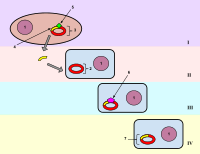
Photo from wikipedia
Larix olgensis or larch is an economically important coniferous tree species with rapid growth in the early stages, strong adaptability, and a short time to harvest. The genetic improvement of… Click to show full abstract
Larix olgensis or larch is an economically important coniferous tree species with rapid growth in the early stages, strong adaptability, and a short time to harvest. The genetic improvement of larch has garnered considerable attention in recent years for reclaiming timber forests. However, traditional breeding methods are largely ineffective for achieving rapid genetic improvement of L. olgensis. Studies show that the efficiency of plant regeneration can be improved by optimizing somatic embryogenesis. On this basis, we devised a stable, fast and efficient Agrobacterium-mediated genetic transformation method using suspended embryogenic calluses as explants and β-glucuronidase as the reporter. We evaluated the effects of the Agrobacterium load, co-culture period, and addition of acetosyringone and transformant screening antibiotic on the transformation efficiency. In addition, we tested the pCAMBIA 1300-PtHCA 2-1 promoter-GUS binary expression vector, which contains the GUS gene ORF under the control of Populus trichocarpa high cambial activity PtHCA 2-1 promoter, and observed the tissue-specific expression of the GUS gene in the somatic embryos of transgenic larch. This novel technique can not only accelerate the generation of superior transgenic strains of L. olgensis but also aid in future gene functional studies.
Journal Title: Frontiers in Plant Science
Year Published: 2020
Link to full text (if available)
Share on Social Media: Sign Up to like & get
recommendations!